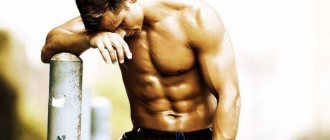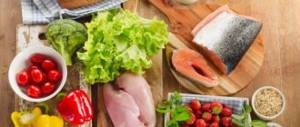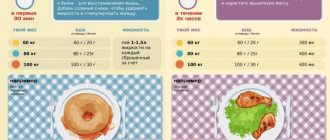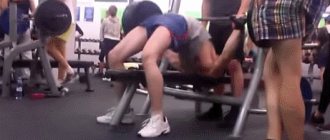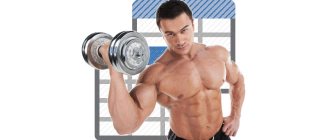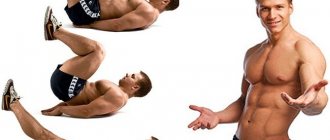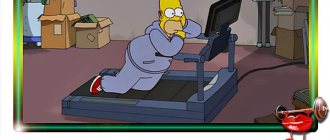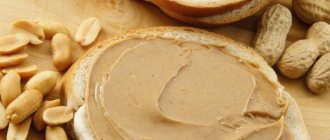Article provided by t-day.com.ua 2014-05-11 Views: 45,808 Rating: 5.0
| Medals articles >> |
Articles are loading...
In order to achieve excellent results and get the most out of your workouts, you need to pay attention to such a factor as the protein-carbohydrate window that occurs after the end of strength work.
The protein-carbohydrate window is a term that refers to the period that occurs within half an hour after a high-intensity strength training session.
The thing is that the body at this time needs to replenish muscle glycogen reserves, as well as to reduce the level of cortisol and adrenaline, which have a detrimental effect on muscle tissue. Raising the level of insulin, which inhibits catabolic processes, will help reduce the destructive effect of these hormones. Thus preventing the muscles from being destroyed. To maximize insulin levels, you need to eat carbohydrates with a high glycemic index (mainly sweet and starchy foods).
What is the carbohydrate window?
So, even a person far from sports knows well that after good physical activity a good appetite appears. Doctors advise at this moment to refrain from eating and postpone it for 2-3 hours later. This is explained by the fact that a person is not able to properly control his hunger after exercise, so he can simply overeat.
So, what is the protein-carbohydrate window? The very period of time when a person after a workout feels a “wolfish appetite” is exactly that. At this moment, a whole chain of biochemical processes occurs in the body , thanks to which it is able to very quickly absorb both carbohydrates and proteins. The former provide energy, the latter are building material for muscles. This allows you to quickly restore the body and prevent a lack of nutritional components.
So, what is the post-workout carbohydrate window? This is a period of 30-40 minutes (no more) when the absorption of glucose in the body accelerates.
By the way, the most optimal time for this is no later than 6 pm. It is during this period that the number of enzymes responsible for processing proteins increases in the body in waves. The only thing the body lacks for this is those same carbohydrates.
The role of carbohydrates after exercise
The goal of sports training is to lose weight and build muscle mass. During speed and strength exercises, microcracks form in the muscles. To “repair” them, the body requires protein.
In the first 30-40 minutes after exercise, the body actively synthesizes proteins from amino acids. The process is called anabolism. At the same time, proteins break down and catabolism occurs. For an athlete, it is important that synthesis occurs faster than decay.
Due to the body's need for protein compounds, it is recommended to drink a protein shake after training. But protein synthesis also requires fast carbohydrates.
Penetrating into the body, these substances are synthesized into glucose and used to produce energy. Excess carbohydrates are stored as subcutaneous fat and glycogen in muscles. The latter is consumed quickly. If you do not replenish the lack of glucogen after exercise with food, the body begins to synthesize it from amino acids contained in the muscles. The process is influenced by the hormone cortisol, produced after stress. Protein breakdown accelerates and synthesis slows down.
Carbohydrates entering the body immediately after training stimulate anabolism and slow down catabolism, regulating hormonal levels:
- They activate insulin production, helping amino acids to “repair” existing cracks in muscle tissue. Insulin is produced in response to the intake of carbohydrate and protein foods.
- The combination of proteins and carbohydrates increases the level of growth hormone. It accelerates anabolism and slows down catabolism, helping to build muscle mass.
- The volume of the hormone cortisol, which destroys muscles, decreases. It stimulates the release of amino acids from muscle tissue, which causes protein compounds to break down. The less cortisol, the better for muscle growth.
Important! Carbohydrates are only beneficial post-workout if consumed in combination with protein.
- See also what carbohydrate and fat blockers are
Why do you need to close the white-carbohydrate window?
Is it necessary to close the carbohydrate window after training, since doctors do not recommend starting to eat right away? If you rationally approach the choice of diet and do not exceed the permissible portion (in kilocalories), then, of course, it is necessary! This will not only accelerate muscle growth , but will also prevent loss of strength.
A “shock” portion of glucose after physical activity promotes the production of growth hormone and also increases the concentration of insulin in the blood. All this together contributes to faster protein absorption.
If you constantly use the glucose-carbohydrate window in training, then muscle mass will be gained as quickly as possible. With this diet, the body absorbs 30-40 grams of protein , which goes specifically to building muscle mass . Therefore, if you are pursuing the goal of building muscle, do not neglect the carbohydrate window and replenish your energy reserves on time.
What happens if you fast after a workout?
- Firstly, microdamaged muscles will not be filled with nutrients, which means they will not grow. Therefore, the window is often called anabolic.
- Secondly, stress hormones (cortisol and adrenaline) during fasting after exercise destroy muscles.
- Third, insulin, which is produced by the body when eating carbohydrates, does not increase and does not fight stress hormones.
- Fourthly, with prolonged fasting, metabolism slows down, even for those losing weight who do not gain muscle - this process is destructive. It is known that with a slow metabolism, the body is worse at parting with its own fats.
General information about the protein-carbohydrate diet
The rate of carbohydrate absorption after strength training increases approximately 3-5 times. However, we are talking exclusively about so-called “fast” carbohydrates. These include:
- bananas;
- chocolate;
- nuts;
- cane sugar;
- honey;
- raisin;
- condensed milk;
- jam;
- etc.
That is, the carbohydrate window after training should be closed with foods with a high glycemic index . For proteins, you can make a standard protein shake with a banana . Whey is better, but egg is also allowed. To prepare it you will need:
- 300-400 grams of milk (minimal fat content);
- 1-2 small bananas;
- 3-4 tablespoons of condensed milk;
- 13 teaspoons cinnamon;
- berries. It is best to take 30-40 grams of raspberries or blackberries.
Mix all this thoroughly with a blender, then mix in a shaker. Naturally, the cocktail is prepared in advance . You should drink it in small sips immediately after finishing your strength training. Thus, the athlete will close the protein-carbohydrate window.
If you don’t have time to cook, you can use ready-made protein bars. They contain up to 30% high-quality protein and a “shock” dose of glucose, which is what the body needs for rapid recovery.
Restoring muscle glycogen
To restore glycogen in muscles, it is recommended to consume large doses of carbohydrates immediately after training. Glycogen is a carbohydrate stored in muscles, which is used as a source of energy during training or simply performing heavy physical work.
Consuming carbohydrates immediately after exercise increases glycogen levels by 16% more than consuming plain water immediately after exercise.
That is, by challenging your body to digest and assimilate carbohydrates, you will improve carbohydrate storage by only 16% better than if you drink water. And it is not difficult for the body to absorb water.
That is, glycogen accumulation occurs within 24 hours after training. And to maximize the accumulation of glycogen in muscles, it is not a quick intake of carbohydrates immediately after a workout that is required, but a stable nutrition of the body for 24 hours after the end of the workout. That is, over the next 24 hours after finishing classes in the gym, you need to eat properly and often.
Conclusion: You need to consume carbohydrates within 24 hours after your workout.
Experiments show that after strength training, insulin sensitivity increases, which means carbohydrates are utilized more efficiently. Therefore, overweight people and diabetics are recommended to reduce insulin resistance through strength training. According to Koopmann et al.'s 2005 study, insulin sensitivity remains elevated for 24 hours after exercise.
Conclusion: Immediately after training, it is not necessary to immediately fill your stomach with carbohydrates, especially solid ones. It is quite possible to get home and already there eat a heavy meal of carbohydrates: potatoes, porridge, rice, or drink a portion of a gainer. That is, the daily amount of carbohydrates consumed is important, and not just those consumed after training.
Post-workout protein or carbohydrates? Or maybe together?
It is believed that proteins are better absorbed with carbohydrates after exercise. The logic is that carbohydrates cause the release of insulin, a transport hormone that helps carbohydrates and proteins be better absorbed. But, experiments (Tipton et al. 2001) regarding the absorption of mass gainers show that protein synthesis is 30% less if you eat immediately after training.
Carbohydrate window when losing weight - how to close it?
What is the carbohydrate window after a weight loss workout? It is recommended to slightly increase the portion of proteins, but decrease carbohydrates . So-called “fitness bars” based on simple cereals are ideal for this purpose.
Is it possible to prepare a cocktail to close the carbohydrate window from natural ingredients? The simplest recipe:
- skimmed milk;
- 20-30 grams of whey protein;
- 1 tablespoon of condensed milk, honey or cane sugar (fructose is also great, but it takes much longer to break down);
- 1 medium pear.
It should be taken into account that the proposed options are suitable exclusively for building muscle mass and specifically for men . The option for losing weight is also suitable for women, you just need to remember about the permissible daily dose of protein . For men it is 2.5 grams per kilogram of live weight, for women it is 1.55-1.65 grams . The protein-carbohydrate window makes up approximately 15-20% of the total daily diet. This “dosage” should not be exceeded.
Closing the window while gaining weight
Muscles do not grow during training, but after it ends. During the training period, muscle fibers are injured, the body makes attempts to restore them with a reserve in order to withstand the load in the future. As a result, replenishing resources at this stage is extremely important.
At the end of grueling training, the content of adrenaline and cortisol within the body sharply increases. The body becomes stressed during exercise because these hormones cause the breakdown of muscles that a person is struggling to build.
To block the action of hormones, you will need fast carbohydrates. They provoke the production of insulin, which is their antagonist. The anabolic window makes it possible not to be afraid that the food eaten will be deposited in fat accumulation, as the rate of metabolic processes will increase.
It is recommended to slightly increase the amount of proteins and reduce carbohydrates. “Fitness bars” made from regular cereals are ideal for these purposes. It is possible to make a cocktail to close the protein window from natural ingredients. Recipe:
- low-fat milk;
- 25 g whey protein;
- 1 tbsp. l. condensed milk, honey or sugar (it is possible to use fructose, but the breakdown will take longer);
- 1 pear.
It should be borne in mind that this version of the cocktail is only suitable during muscle building and directly for males. The protein-carbohydrate window should be approximately 15% of the diet. It is not recommended to increase this “dosage”.
An athlete's need for protein is extremely high, but this component is not well absorbed in all cases. An insufficient amount of digested protein helps slow down the process of gaining muscle mass. This will be another reason to take advantage of the post-workout carbohydrate window.
Given that the protein window is quite short, every minute matters. It will not be possible to take advantage of its advantages when the athlete is used to snacking only when he comes home from the gym.
Carbohydrate window for “drying”
In strength training, there is also such a thing as “drying”. Simply put, getting rid of fat mass while maintaining the muscle mass already gained. Used by both men and women. How to close the carbohydrate window in this case? Even professional trainers recommend using a multicomponent gainer (with the addition of vitamins and minerals). There the concentration of proteins and glucose is already balanced, and there is no fat at all.
How to close the carbohydrate window after training during the drying process, using only natural ingredients? The best option is a mixture of milk, whey protein (soy protein should not be used) and 1-2 small bananas.
The dosage of proteins is chosen as standard for an adult with physical, but not strength, activity. Simply put, during the cutting process, men 3 grams of protein per kilogram of live weight daily, women – up to 1.75 .
Closing the protein-carbohydrate window when losing weight, you will need up to 25-30 grams of protein and 80-120 grams of carbohydrates. Don't forget about berries and ascorbic acid - it also plays an important role in the breakdown of proteins (400 mg per day is more than enough).
Is the carbohydrate-protein window theory true?
Recently, there have been many controversial issues regarding the theory of the carbohydrate-protein window. It has been proven that post-workout nutrition is just as important as pre-workout nutrition. Don't forget that you need to eat before training. Consuming proteins and carbohydrates in your diet beforehand is the key to good strength performance during training. There is a minimum of catabolic processes in the body. Optimally, you need to get more than ten grams of pure protein (protein) and fast carbohydrates before starting your workout.
What happens if you don't close the carbohydrate window?
Is it really so important to observe that same carbohydrate window? What happens if you completely stop eating after physical activity?
- Firstly, it will partially disrupt metabolism .
- Secondly, the person will feel too tired even for everyday activities.
- Thirdly, a situation may arise when an athlete visits the gym 3-4 times a week, but this does not affect his figure at all. That is, muscle mass gain does not occur .
All this is an individual physiological feature, but it lies precisely in an incorrectly selected diet or a disruption in the process of protein absorption. And the carbohydrate window is an excellent opportunity to more properly prepare your body for muscle building.
If we are not talking about strength training, but, for example, about fitness, then you should not increase the concentration of carbohydrates after exercise. After all, all metabolic processes start precisely after the breakdown of acid in the muscles. With fitness, this does not always happen.

